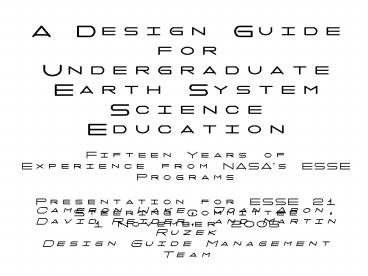A Design Guide for Undergraduate - PowerPoint PPT Presentation
1 / 8
Title:
A Design Guide for Undergraduate
Description:
1 Dec Prototype of Design Guide Web Page available for comment ... 10 Jul Design Guide 'brochure' completed; web site fully functional ... – PowerPoint PPT presentation
Number of Views:35
Avg rating:3.0/5.0
Title: A Design Guide for Undergraduate
1
A Design Guide for Undergraduate Earth System
Science Education Fifteen Years of Experience
from NASAs ESSE Programs Cameron Wake, Joan
Aron, David Reider, and Martin Ruzek Design Guide
Management Team
Presentation for ESSE 21 Steering Committee 1
November 2005
2
Design Guide Objectives and Audience
The primary objective of the proposed Design
Guide for Undergraduate Earth System Science
Education is to analyze and summarize ESSE
experiences over the past 15 years that will
assist faculty at a wide range of higher
education institutions develop and deliver Earth
System Science classes and curriculum. Primary
Audience Faculty teaching or who are
interested in teaching ESS at the undergraduate
level practioners. Secondary Audience
Administrators interested in developing
undergraduate ESS curriculum The Design Guide
will also provide context for other ESSE21
products including the exemplary learning modules
and the evaluation toolkit.
3
DG Format and Building Blocks
Developed and produced via a collaboration of
ESSE21 participants through the collection,
analysis, and summary of the common
elements/lessons learned/effective practices
based on the 63 education experiments that ESSE
and ESSE 21 have funded over the past 15
years. The information will be assembled into
a living document on a dedicated web site, as
well as described briefly in a printed
brochure. Organized into a series of
sections, each led by a designated author made up
of current and past ESSE participants
4
DG Format and Building Blocks
- Forma will be driven by at five key
characteristics. - Content is being developed for delivery via a web
site. Information will be layered, with answers
to key questions providing a quick overview of
sections (Why is this important? What is in this
section?). - Navigation of the web site will take into
consideration different modes of learning based
on key building blocks (sections, FAQs, case
studies/vignettes, cross cutting themes, key
links). - Inviting, attractive, clear , and relatively
simple web site. - Virtual appendix that includes ESS bibliography,
ESSE I, II and 21 syllabi and courses, key links. - Ensure section 508 compliance.
- Future Directions and Opportunities
5
Design Guide Section Headings and Lead Authors
- I. The Scientific Framework of Earth System
Science - (Owen Thompson)
- Teaching, Learning, and Evaluaiton (David Baker)
- III. Effecting Internal Institutional Changes
(Don Wuebbles) - IV. Developing External Partnerships and a
Community Framework (Molly Davies) - V. ESS and the STEM Pipeline (Martin Ruzek)
- VI. Contributing to a Diverse Workforce (Brenda
Chee-Wah) - VII. Exemplary ESS Learning Resources (Joan
Aron) - VIII. ESS Data and Tools (Anupma Prakash)
- Future Directions and Opportunites for ESSE
(DG Management Team)
6
Design Guide Cross Cutting Themes
A Integrated interdisciplinary system - ESS
characterized by the study of Earth as an
integrated system interdisciplinary study of
often complex and dynamic interactions) among
major components. B Humanity is a part of the
system - Recognition that humans and human
activities play a major role in the Earth System.
We are drivers of change in the system and we
are affected by that change. C Temporal and
spatial scales of the system - Extrapolating
place based measurements to global scales, or
investigating change over time. Critical for
key applications such as climate change,
ecosystem degradation, and biodiversity. D ESS
as a source of information for moving towards a
more sustainable system - Earth System Science
provides a foundation for informing societies
efforts to become more sustainable.
E Relevance and inspirational value of ESS -
ESS provides the opportunity for students to
pursue their desires to make a difference in the
world and to make the world a better place and to
do this with data analysis and interpretation
using new technologies. This WOW factor and can
inspire students and the general public.
7
Design Guide Cross Cutting Themes
Note on Section IX Selected themes should
receive special emphasis on development in the
future but they will build on all of the other
cross-cutting themes
8
Timeline (dates for key deliverables)
8 Nov Finalize consulting agreements with
authors 1 Dec Prototype of Design Guide Web
Page available for comment 20 Dec Detailed
outline of section contents due from section
authors 16 Jan DG website online for beta testing
with sample section 3 Feb Working drafts due of
each section from authors 4-8 Feb DGMT review
and editing of section drafts 9 Feb Working
meeting with section authors and DGMT
SC 10-24Feb Review of sections by SC 3 Apr
Final section writing due from authors 12 Apr
DGMT acceptance review of final section
writing 13 Apr DGMT meet to harmonize content,
identify gaps, finalize web 15 Apr Deadline for a
beta version of the modules 14-28Apr SC final
review of DG May Final editing by DGMT section
writing and web site 10 Jul Design Guide
brochure completed web site fully
functional 24 Jul Official rollout of DG website
brochure at ESSE 21 meeting































